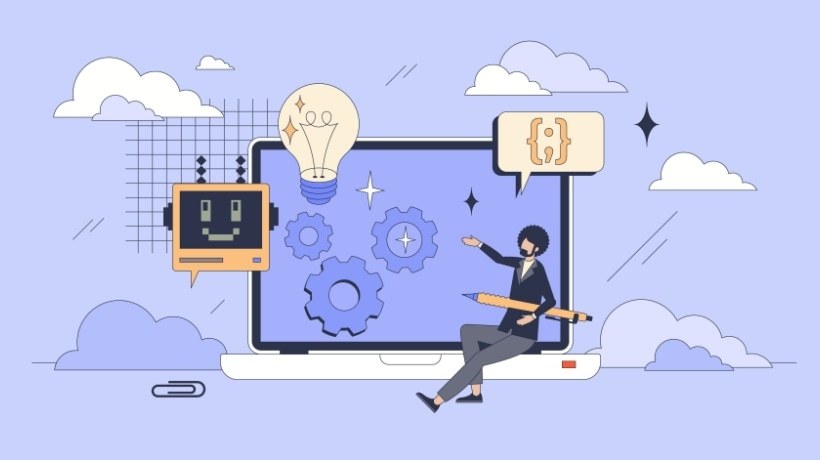Signs It's Time To Replace Your LMS
For many organizations, the Learning Management System (LMS) has been the backbone of training operations—tracking courses, managing enrollments, and storing certifications. But as learning becomes more continuous, adaptive, and AI-assisted, many traditional LMSs are struggling to keep up. The signs often start small—manual reporting, disengaged learners, slow updates—but soon they snowball into lost productivity, poor learner experience, and limited innovation.
If your LMS feels more like a roadblock than a learning enabler, it might be time for a change. Today's forward-thinking enterprises are moving toward no-code platforms integrated with agentic AI capabilities, enabling them to create dynamic, personalized learning ecosystems without relying on months of development or IT intervention. Let's look at the five key signs it's time to replace your LMS—and how no code + AI can help future-proof your learning strategy.
1. Manual Work Is Draining Your L&D Team
If your team spends more time managing spreadsheets, emails, and manual workflows than actually improving learning outcomes, that's a clear red flag. Traditional LMSs often require repetitive administrative work—uploading content, tracking attendance, generating reports, managing compliance—much of which could easily be automated.
- Why this matters
Manual work leads to burnout, delays, and errors. It limits your L&D team's ability to innovate or focus on learner engagement. - How no code + agentic AI helps
With no code, you can automate these processes in just a few clicks. Agentic AI takes it a step further—it can act as a learning operations assistant, identifying inefficiencies, triggering reminders, and even generating performance reports autonomously.
Imagine an AI agent that not only updates training records but also suggests follow-up learning modules based on employee performance. That's the level of proactive intelligence modern organizations are adopting.
2. Learner Engagement Is Declining
If participation rates are dropping or completion rates are stagnant, your LMS might be delivering content—but not connection. Today's learners expect interactive, personalized, and intuitive experiences—similar to the digital apps they use every day. Legacy LMSs, built for compliance and tracking rather than engagement, can’t deliver on those expectations.
- Why this matters
Low engagement doesn't just affect learning outcomes—it also impacts ROI. A disengaged workforce means your training investment isn't translating into real skills or performance gains. - How no code + agentic AI helps
No-code platforms allow you to design dynamic, gamified, and adaptive learning experiences—without writing code. Add AI to the mix, and you can go beyond personalization:
-
- Agentic AI can recommend courses based on skills gaps.
- It can simulate learning journeys unique to each employee.
- It can even generate interactive content or quizzes automatically, keeping learners challenged and motivated.
Your L&D ecosystem shifts from being a static course repository to a living, learning environment that evolves with each employee.
3. Your LMS Can't Keep Up With Change
Business priorities shift quickly—new tools, new policies, new skills. But if updating your LMS or integrating new features requires months of development or external vendor support, it's holding your organization back. Traditional systems are rigid by design. Adding new functionalities or integrating them with other enterprise tools (like HRMS, CRM, or BI platforms) often becomes a costly, time-consuming project.
- Why this matters
Agility in learning operations is key to maintaining business competitiveness. When your LMS can't evolve with your organization, it becomes a bottleneck instead of a backbone. - How no code + agentic AI helps
No-code platforms empower L&D teams to build and modify applications instantly—from onboarding dashboards to performance analytics—without depending on IT. Meanwhile, agentic AI capabilities enable systems that can self-adapt:
-
- Detect new training needs based on company data.
- Recommend workflow updates automatically.
- Build new learning modules using existing content repositories.
This means your learning infrastructure stays agile, responsive, and future-ready—even as your business transforms.
4. You're Flying Blind On Learning Impact
Are you confident about how learning programs affect performance? If your LMS makes it hard to track skills growth, productivity improvement, or ROI, you're operating in the dark. Traditional systems often focus on completion metrics, not outcomes. They tell you how many people took a course—but not how learning changed their performance or mindset.
- Why this matters
Without actionable insights, it's difficult to prove the strategic value of L&D. It also limits your ability to continuously improve training effectiveness. - How no code + agentic AI helps
With no-code analytics and agentic AI, you can create dashboards that connect learning data to business results—without relying on developers or external data teams. AI agents can analyze learner progress, engagement levels, and performance outcomes in real-time—and even generate insights automatically:
-
- "Sales team productivity increased by 15% after completing the negotiation module."
- "Customer satisfaction scores improved by 20% in regions where microlearning was deployed."
Instead of static reports, you get living insights that evolve with your organization's goals.
5. You're Missing The Power Of Integration
Modern L&D doesn't operate in isolation—it's part of a broader digital ecosystem that includes HR, project management, productivity, and communication tools. If your LMS doesn't integrate seamlessly with these systems, you're creating data silos and fragmented learning experiences.
- Why this matters
Disconnected systems lead to poor visibility, redundant data entry, and lost opportunities for personalized, contextual learning. - How no code + agentic AI helps
- No-code platforms are built with plug-and-play integrations—connecting your learning workflows to tools like Slack, Teams, CRM, or HRMS instantly. With agentic AI, these integrations become intelligent:
-
- AI can fetch performance data from HR systems to update learning recommendations.
- It can trigger learning prompts within collaboration tools based on real-time project activity.
- It can even automate onboarding across multiple platforms, ensuring new hires get everything they need without manual setup.
This creates a unified learning environment—one that's integrated, intelligent, and effortlessly scalable.
The Future Of Learning: From LMSs To Living Learning Systems
The modern enterprise can no longer rely on static systems to drive dynamic growth. Learning today is not about managing content—it's about orchestrating continuous development. No-code platforms with agentic AI are transforming how organizations think about learning infrastructure:
- No code empowers creators.
L&D teams can build their own workflows, reports, and portals—no coding or IT dependency. - AI empowers intelligence.
Agents learn from user behavior, adapt to organizational goals, and automate complex decisions. - Together, they empower transformation.
The result is a living, responsive learning ecosystem that evolves as your workforce does.
Instead of asking, "Can our LMS handle this?" organizations are beginning to ask, "What new possibilities can we unlock next?"
Before Vs. After: How Learning Transforms With No Code + Agentic AI
Spotting the warning signs is only half the story—the real value lies in seeing what transformation looks like once you move beyond a traditional LMS. The shift from static systems to no-code platforms powered by agentic AI represents more than a software upgrade; it's a complete mindset change in how organizations design, deliver, and measure learning. Here's a snapshot that captures the difference:
- Content management
Manual uploads and frequent content updates handled by admins or IT teams.
AI agents auto-generate, curate, and update content dynamically—keeping learning materials fresh and relevant. - Personalization
One-size-fits-all courses with limited flexibility or learner adaptation.
AI analyzes user behavior, performance, and goals to deliver adaptive learning paths that evolve with each learner. - Reporting and analytics
Static, manual reports that offer limited insights and require data exports.
Real-time, AI-generated insights that track learning impact, predict engagement trends, and tie outcomes to performance metrics. - Customization
Changes or new workflows depend on IT support or vendor intervention—often slow and costly.
Drag-and-drop customization empowers L&D teams to design courses, dashboards, and workflows instantly, with no coding required. - Automation
Manual follow-ups, reminders, and course assignments handled by administrators.
Agentic AI automates learning operations—sending personalized nudges, managing enrollments, and optimizing training timelines autonomously. - Scalability and agility
Slow upgrades and limited scalability; each new requirement demands technical effort.
Modular, cloud-native architecture enables instant scaling and rapid deployment across departments or regions. - Integration
Limited or complex integrations with HRMS, CRM, and other enterprise tools.
Built-in connectors and intelligent agents that seamlessly integrate learning across systems, creating a unified digital ecosystem.
What This Means For L&D Leaders
The move from a traditional LMS to a no code + agentic AI platform is a shift from management to orchestration.
- Learning isn't something you track anymore—it's something your system continuously optimizes.
- L&D teams don't just deliver training—they design living, intelligent workflows that grow with business needs.
- And most importantly, technology moves from being a tool you maintain to a partner that evolves alongside your learners.
This transformation empowers organizations to future-proof their learning operations, reduce manual dependencies, and create personalized, data-driven experiences that keep pace with modern business agility.
Conclusion
Your LMS was built for a different era—an era where training was linear, compliance-driven, and siloed. But the way people learn has changed. Learning is now continuous, contextual, and co-created. If your current LMS is slowing you down, it's not just a technology issue—it's a business risk. Inefficient workflows, disengaged learners, and limited adaptability can all erode the impact of your L&D investments. That's why many organizations are choosing no-code platforms with agentic AI capabilities as their next step. They offer:
- Speed
Build or modify learning systems in days, not months. - Intelligence
Use AI agents to personalize, automate, and optimize learning. - Scalability
Integrate easily with enterprise systems and grow without friction.
This shift isn't just about replacing an LMS—it's about redefining how learning operates. By combining the agility of no code with the intelligence of AI, organizations are creating ecosystems that learn as they grow, where technology acts not as a tool but as a teaching partner.
So if any of these five signs sound familiar, take them as a cue. It might be time to say goodbye to your legacy LMS and hello to a smarter, faster, more connected way of learning.






